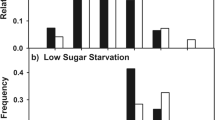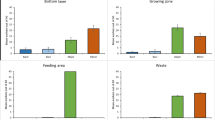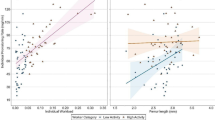Summary
During recruitment, running velocity of both outbound and laden workers of the leaf-cutting ant Acromyrmex lundi depended on the information about resource quality they received from the first successful recruiter. In independent assays, single scout ants were allowed to collect sugar solutions of different concentrations and to recruit nestmates. Recruited workers were presented with standardized paper discs rather than the sugar solution given to the original recruiting ant. Outbound recruited workers were observed to run faster the more concentrated the solution found by the recruiter. Speed of disc-laden workers also depended on the concentration of the solution found by the recruiter, i.e. on the information about food quality they received, since they had no actual contact with the sugar solution. Disc-laden workers ran, as intuitively expected, slower than outbound workers. The reduction in speed, however, could not be attributed to the effects of the load itself, because workers collecting discs of the same weight, but with added sugar, ran as rapidly as outbound, unladen workers. Workers collecting standardized sugared discs reinforced the chemical trail on their way to the nest. The percentage of trail-layers was higher when workers were recruited to 10% than to 1% sugar solution, even though they collected the same kind of discs at the source. Their evaluation of resource quality, therefore, depended on their motivational state, which was modulated by the information they received during recruitment. Using previously published data on energetics of locomotion in leaf-cutting ants, travel costs of A. lundi workers recruited to sugar solutions of different concentration could be estimated. For workers recruited to the more concentrated solution, both speed and oxygen consumption rate increased by a roughly similar factor. Therefore, although workers ran faster to the high-quality resource, their actual energy investment per trip remained similar to that made by workers recruited to the low-quality resource. It is suggested that the more motivated workers reduced travel time without increasing energy costs during the trip. The adaptive value of these responses seems to be related to a rapid transmission of information about a newly discovered food source.
Similar content being viewed by others
References
Balderrama NM, Almeida de Balderrama LO, Núñez JA (1992) Metabolic rate during foraging in the honey bee. J Comp Physiol B 162:440–447
Baroni-Urbani C, Buser MW, Schilliger E (1988) Substrate vibration during recruitment in ant social organization. Insectes Soc 35:241–250
Beckers R, Dencubourg JL, Goss S (1992) Trail laying behaviour during food recruitment in the ant Lasius niger (L.). Insectes Soc 39:59–72
Breed MD, Fewell JH, Moore AJ, Williams KR (1987) Graded recruitment in a ponerine ant. Behav Ecol Sociobiol 20:407–411
Cherrett JM (1972) Some factors involved in the selection of vegetable substrate by Atta cephalotes (L.) (Hymenoptera: Formicidae) in tropical rain forest. J Anim Ecol 41:647–660
Fowler H (1979) Environmental correlates of the foraging of Acromyrmex crassispinus. Cienc Cult 31:879–882
Frisch K von, Lindauer M (1955) Über die Fluggeschwindigkeit der Bienen und über ihre Richtungsweisung bei Seitenwind. Naturwissenschaften 42:377–385
Fuchs S (1976a) The response to vibrations of the substrate and reactions to the specific drumming in colonies of carpenter ants (Camponotus, Formicidae, Hymenoptera). Behav Ecol Sociobiol 1:155–184
Fuchs S (1976b) An informational analysis of the alarm communication by drumming behavior in nests of carpenter ants (Camponotus, Formicidae, Hymenoptera). Behav Ecol Sociobiol 1:315–336
Hahn M, Maschwitz U (1985) Foraging strategies and recruitment behaviour in the European harvester ant Messor rufitarsis (F.). Oecologia 68:45–51
Hangartner W (1969) Structure and variability of the individual odor trail in Solenopsis geminata Fabr. (Hymenoptera, Formicidae). Z Vergl Physiol 62:111–120
Hangartner W (1970) Control of pheromone quantity in odor trails of the ant Acanthomyops interjectus Mayr. Experientia 26:664–665
Harrison JF, Fewell JH, Stiller TM, Breed MD (1989) Effects of experience on use of orientation cues in the giant tropical ant. Anim Behav 37:869–871
Hölldobler B (1976) Recruitment behavior, home range orientation and territoriality in harvester ants, Pogonomyrmex. Behav Ecol Sociobiol 1:3–44
Jaffé K, Howse PE (1979) The mass recruitment system of the leaf cutting ant, Atta cephalotes. Anim Behav 27:930–939
Lewis T, Pollard GV, Dibley GC (1974) Rhythmic foraging in the leaf-cutting ant Atta cephalotes (L) (Formicidae: Attini). J Anim Ecol 43:129–141
Lighton JRB, Bartholomew GA, Feener DH (1987) Energetics of locomotion and load carriage and a model of the energy cost of foraging in the leaf-cutting ant Atta colombica Guer. Physiol Zool 60:524–537
Littledyke M, Cherrett JM (1978) Olfactory responses of the leaf-cutting ant Atta cephalotes (L.) and Acromyrmex octospinosus (Reich) (Hymenoptera: Formicidae) in the laboratory. Bull Entomol Res 68:273–282
Lutz FE (1929) Observations on leaf-cutting ants. Am Mus Novit 388:1–21
Markl H, Hölldobler B (1978) Recruitment and food-retrieving behavior in Novomessor (Formicidae, Hymenoptera). II: Vibration signals. Behav Ecol Sociobiol 4:183–216
Moser JC, Blum MS (1963) Trail marking substance of the Texas leaf-cutting ant: source and potency. Science 140:1228
Nunez JA (1974) Metabolism and activity of the worker bee. In: Harnaj V, Schwindt-Escalante O (eds) Proceedings of the 24th Apimondia International Apiarist Congress. Apimondia Ediciones, Buenos Aires, pp 298–299
Rissing SW (1982) Foraging velocity of seed-harvester ants, Veromessor pergandei (Hymenoptera: Formicidae). Environ Entomol 11:905–907
Roces F (1990a) Olfactory conditioning during the recruitment process in a leaf-cutting ant. Oecologia 83:261–262
Roces F (1990b) Leaf-cutting ants cut fragment sizes in relation to the distance from the nest. Anim Behav 40:1181–1183
Roces F, Núñez JA (1993) Information about food quality influences load-size selection in recruited leaf-cutting ants. Anim Behav 45:135–143
Rudolph SG, Loudon C (1986) Load size selection by foraging leaf-cutter ants. Ecol Entomol 11:401–410
Schmaranzer S, Stabentheiner A (1988) Variability of the thermal behavior of honeybees on a feeding place. J Comp Physiol B 158:135–141
Shutler D, Mullie A (1991) Size-related foraging behaviour of the leaf-cutting ant Atta colombica. Can J Zool 69:1530–1533
Stabentheiner A, Hagmüller K (1991) Sweet food means “hot dancing” in honeybees. Naturwissenschaften 78:471–473
Waller DA (1989) Size-related foraging in the leaf-cutting ant Atta texana (Buckley) (Formicidae: Attini). Funct Ecol 3:461–468
Wilson EO (1962) Chemical communication among workers of the fire ant Solenopsis saevissima (Fr. Smith). Anim Behav 10:134–163
Wilson EO (1980) Caste and division of labor in leaf-cutting ants (Hymenoptera: Formicidae: Atta). II. The ergonomic optimization of leaf cutting. Behav Ecol Sociobiol 7:157–165
Author information
Authors and Affiliations
Rights and permissions
About this article
Cite this article
Roces, F. Both evaluation of resource quality and speed of recruited leaf-cutting ants (Acromyrmex lundi) depend on their motivational state. Behav Ecol Sociobiol 33, 183–189 (1993). https://doi.org/10.1007/BF00216599
Received:
Accepted:
Issue Date:
DOI: https://doi.org/10.1007/BF00216599




